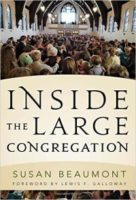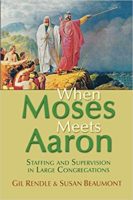“Growth in membership is the primary indicator of congregational health and vitality.” The pandemic is challenging this and other longstanding assumptions about engagement, belonging, and membership. We must carefully examine all of our assumptions—otherwise, we risk creating barriers to belonging for people trying to engage with us in new ways.
During the pandemic, people are finding meaningful new ways to connect with us online in worship, programs, and service. These connections do not look anything like what we previously recognized as engagement.
We are eager to return to our buildings and in-person interaction because that is what we are designed to do. However, online church is here to stay. As we return to our buildings, many congregations will maintain an online presence because not everyone is ready or able to return to physical spaces. Even some of our longest-standing members are discovering that they prefer virtual engagement for some parts of church life.
What happens to our newly-formed online communities as we return to our buildings? Do online participants become second-class citizens? If we do not examine our unstated assumptions about belonging, we risk losing our newest constituents, or relegating them to a “lesser” status.
In the paragraphs that follow, I will challenge five long-standing assumptions about belonging, engagement and membership that are crumbling now. No doubt you can name others.
Geography dictates belonging.
Pull out a map and draw a five-mile circle around the church building. We have long believed that this circle represents the pool from which we draw our constituents. People will not drive more than 20 minutes to engage a church -right?
The pandemic has shifted our reality. In the time we have been out of our buildings many of us have discovered new constituent relationships that have nothing to do with geography.
It is delightful to consider that we are no longer limited by physical boundaries. However, this raises new questions about how we define our identity and our context. Who are we now? Who do we serve now? What, if anything does membership mean to someone who does not interact in our physical space? Is their engagement less important to us than the people who are physically present?
Discipleship begins with membership.
Once upon a time, new-member assimilation was the primary means by which people were drawn into discipleship and set onto a path of faith development and spiritual growth. People came to worship first and then they joined the church. Then they were drawn into true belonging. Through participation in the life of the church—on the other side of their decision to join—people were guided inward in faith and outward in service and leadership.
Now the journey often works in reverse. People connect with us in order to serve, and service helps them to belong. People need to feel that they belong before they join. Some people are not interested in membership at all. They may or may not attend worship. People are finding ways to belong outside the bonds of membership. But certain parts of the discipleship journey—such as serving in leadership—are traditionally denied to non-members.
Many of us have failed to alter our discipleship process to reflect these shifting realities. Now we have no choice but to let this failed assumption die. We are obliged to disciple people who are finding us online. Their engagement will not look like the journey described above. What will it mean to belong for those who have no relationship to our physical space or our physical gatherings?
Worship participation is the best indicator of member engagement.
This assumption has not been true for a while, but you would not know it from the records we keep and the metrics we obsess over. When asked how large a congregation is, we describe something about the size of the membership body or the average weekend worship attendance. Both metrics have been faltering as effective measures of the engaged body. Engaged people are worshipping with less frequency and many people who belong to the congregation do not become members.
Virtual worship is posing new challenges for our reporting systems. We might be able to tell how many devices are logged on to a worship service or class, but we do not know how many people are engaged at the logged-on site. And we do not know anything about the nature of their engagement.
We need new ways of measuring and talking about engagement now. What does authentic engagement look like in a virtual world? How will we measure and track it? What are the levels of engagement that we are trying to lead people through and how does that relate to their discipleship?
In-person engagement is more authentic than online engagement.
“When will we be able to get back to real worship?” This is a common question posed by those who find sacred space in physical sanctuaries. The question reveals an assumption that the virtual worship experiences we are having are less than authentic. Certainly, some people feel that way.
However, new people finding their way to us online probably do not share this assumption. They are finding something sacred in the virtual interaction and the space from which they engage that interaction—their home.
As we re-enter our buildings, it behooves us to remember that there are people who want to worship, learn, and serve with us, but they are not interested in our buildings.
The virtual experience raises another distinction to consider. Some worship experiences are pre-recorded. Others are offered live, but they are also recorded for more convenient viewing later. People can worship and learn in a time and space that is different from the time and space of the teacher. Does it matter to us whether people are engaging life in the church synchronously or asynchronously? Is an asynchronous worshiper a lesser engaged constituent?
Belonging requires owning the “whole” church.
Historically, choosing to become a member of a congregation included a commitment to support the full ministry of the congregation. No one is expected to participate in every aspect of congregational life. However, members are expected to understand, support, and financially underwrite the full ministry of the church. If you are not a member, not much is really expected of you.
The pandemic is drawing this assumption, also, into question. Many people who have found their way to us through online worship, service projects, or online classes may have little interest in the full ministry of our congregation. However, we should not dismiss their availability or willingness to support some part of the church that is meaningful to them.
I suspect that some of you reading this article were hoping for more answers and fewer unsettling questions. We are living in liminal times—not yet ready to know the answers to many of the questions facing us. We need to sit in the uncertainty of not knowing for a while yet, as our new normal takes shape. While we wait, we can challenge the old assumptions and work to form better questions about our next chapter.
Susan Beaumont is a coach, educator, and consultant who has worked with hundreds of faith communities across the United States and Canada. Susan is known for working at the intersection of organizational health and spiritual vitality. She specializes in large church dynamics, staff team health, board development, and leadership during seasons of transition.
With both an M.B.A. and an M.Div., Susan blends business acumen with spiritual practice. She moves naturally between decision-making and discernment, connecting the soul of the leader with the soul of the institution. You can read more about her ministry at susanbeaumont.com.




